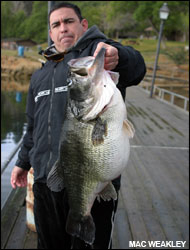
This incredibly fat lake trout caught from Colorado's Blue Mesa reservoir, was a likely all tackle record had it been weighed according to IGFA rules. (Scott Enloe)
If you're into fishing, you're probably aware by now that what was clearly a new all-tackle weight record for lake trout was caught and released May 5 on Colorado's Blue Mesa Reservoir, about 160 miles west of Colorado Springs. The too-fat-to-swim blimp was caught by a father-son team from nearby Gunnison, Scott Enloe and son Hunter.
The senior Enloe pumped up a lake trout that weighed 73.29 pounds and measured nearly four feet long. The fish would have been an IGFA all-tackle record had Enloe chosen to kill it and take it ashore to weigh on a certified scale, but he decided instead to release it to fight again. Enloe, who specializes in catching giant lakers, knew the rules and followed them carefully regarding measuring the length and weight of the fish, recording it all in both still photos and video before releasing. Given that and the absolutely stupendous bulk of the fish, there's not much doubt of the size.

Massive California largemouth like this 25-1, another potential record that was released, also grow to massive size as a result of feeding heavily on stocked trout. (Mac Weakley)
|
Even more amazing than catching a laker that big is catching it in Colorado, which is not lake trout country because there are hardly any natural lakes. Records for the species typically come from huge lakes in northern Canada. The recognized all tackle lake trout record, 72 pounds even, came from Great Bear Lake in the Northwest Territories.
Catching a record class laker in Colorado is something no one would have anticipated until the last few decades when the lake began turning out multiple fish in the 30-pound class and occasionally even a 40 pounder.
The key at Blue Mesa, as in many cases of too-fat-to-swim record class fish, is an abundant food supply. At Blue Mesa, it's kokanee, which the state has stocked by the millions since the 90's. The last four state lake trout records came from the lake, though none approaching Enloe's monster.
The kokanee grow very fast due to the abundant zooplankton in the lake, per state biologists. And that in turn makes the lake trout grow very fast.
However, when lake trout numbers get beyond a certain level, the kokanee population plunges--too many predators and too little food.
That's why the state put an increased harvest program in place on the lake in 2009, encouraging the take of small lakers under 24" while requiring release of trophy class fish. They even held kill tournaments for the smaller fish in 2020 and 2021, awarding cash prizes for taking the smaller fish.
The program clearly worked, and then some. Not only have kokanee numbers increased, the number of trophy class lakers caught has also gone up.
It's a classic case of predator-prey management, much like the mega-largemouth bass caught on some California lakes, where stocked and stupid rainbow trout fatten the bass into basketball-shaped palooka's that often exceed 15 pounds.

Kokanee salmon are gamefish in their own right, but small ones make great forage for jumbo lake trout. (USGS)
Another accidental case is seen in recent years in Lake Ontario and the St. Lawrence River, where 5-pound smallmouth bass are almost the norm in prime time. Biologists say accidentally introduced gobies, which now blanket the bottom throughout the area, have become a super-food for the smallies, causing their amazing growth.
This is all Fisheries Biology 101, true, but it's interesting to see how the predator-prey equation works out repeatedly where ever there are big fish eating little fish.
-- Frank Sargeant
Frankmako1@gmail.com